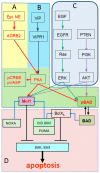ADRB2-Targeting Therapies for Prostate Cancer
- PMID: 30871232
- PMCID: PMC6468358
- DOI: 10.3390/cancers11030358
ADRB2-Targeting Therapies for Prostate Cancer
Abstract
There is accumulating evidence that β-2 adrenergic receptor (ADRB2) signaling contributes to the progression and therapy resistance of prostate cancer, whereas availability of clinically tested β-blocker propranolol makes this pathway especially attractive as potential therapeutic target. Yet even in tumors with active ADRB2 signaling propranolol may be ineffective. Inhibition of apoptosis is one of the major mechanisms by which activation of ADRB2 contributes to prostate cancer pathophysiology. The signaling network that controls apoptosis in prostate tumors is highly redundant, with several signaling pathways targeting a few critical apoptosis regulatory molecules. Therefore, a comprehensive analysis of ADRB2 signaling in the context of other signaling mechanisms is necessary to identify patients who will benefit from propranolol therapy. This review discusses how information on the antiapoptotic mechanisms activated by ADRB2 can guide clinical trials of ADRB2 antagonist propranolol as potential life-extending therapy for prostate cancer. To select patients for clinical trials of propranolol three classes of biomarkers are proposed. First, biomarkers of ADRB2/cAMP-dependent protein kinase (PKA) pathway activation; second, biomarkers that inform about activation of other signaling pathways unrelated to ADRB2; third, apoptosis regulatory molecules controlled by ADRB2 signaling and other survival signaling pathways.
Keywords: BCL-2-associated death promoter (BAD); apoptosis; cAMP-dependent protein kinase (PKA); clinical trial; myeloid cell leukemia 1 (MCL-1); propranolol; prostate cancer; β-2 adrenergic receptor (ADRB2).
Conflict of interest statement
The author declares no conflict of interest. The funders had no role in the design of the study; in the collection, analyses, or interpretation of data; in the writing of the manuscript, or in the decision to publish the results.
Figures


Similar articles
-
Activation of ADRB2/PKA Signaling Pathway Facilitates Lipid Synthesis in Meibocytes, and Beta-Blocker Glaucoma Drug Impedes PKA-Induced Lipid Synthesis by Inhibiting ADRB2.Int J Mol Sci. 2022 Aug 22;23(16):9478. doi: 10.3390/ijms23169478. Int J Mol Sci. 2022. PMID: 36012741 Free PMC article.
-
Behavioral stress accelerates prostate cancer development in mice.J Clin Invest. 2013 Feb;123(2):874-86. doi: 10.1172/JCI63324. Epub 2013 Jan 25. J Clin Invest. 2013. PMID: 23348742 Free PMC article.
-
β2-adrenoreceptor Signaling Increases Therapy Resistance in Prostate Cancer by Upregulating MCL1.Mol Cancer Res. 2020 Dec;18(12):1839-1848. doi: 10.1158/1541-7786.MCR-19-1037. Epub 2020 Sep 14. Mol Cancer Res. 2020. PMID: 32928910 Free PMC article.
-
β-Adrenergic Receptor Signaling in Prostate Cancer.Front Oncol. 2015 Jan 12;4:375. doi: 10.3389/fonc.2014.00375. eCollection 2014. Front Oncol. 2015. PMID: 25629002 Free PMC article. Review.
-
Signaling Pathways That Control Apoptosis in Prostate Cancer.Cancers (Basel). 2021 Feb 24;13(5):937. doi: 10.3390/cancers13050937. Cancers (Basel). 2021. PMID: 33668112 Free PMC article. Review.
Cited by
-
Integrative Analysis of Single-Cell and Bulk RNA Sequencing Reveals Prognostic Characteristics of Macrophage Polarization-Related Genes in Lung Adenocarcinoma.Int J Gen Med. 2023 Nov 3;16:5031-5050. doi: 10.2147/IJGM.S430408. eCollection 2023. Int J Gen Med. 2023. PMID: 37942473 Free PMC article.
-
Functional network analysis reveals potential repurposing of β-blocker atenolol for pancreatic cancer therapy.Daru. 2020 Dec;28(2):685-699. doi: 10.1007/s40199-020-00375-4. Epub 2020 Oct 23. Daru. 2020. PMID: 33098056 Free PMC article.
-
Screening and Identification of Key Common and Specific Genes and Their Prognostic Roles in Different Molecular Subtypes of Breast Cancer.Front Mol Biosci. 2021 Feb 11;8:619110. doi: 10.3389/fmolb.2021.619110. eCollection 2021. Front Mol Biosci. 2021. PMID: 33644115 Free PMC article.
-
Inhibition of signaling downstream of beta-2 adrenoceptor by propranolol in prostate cancer cells.Prostate. 2023 Feb;83(3):237-245. doi: 10.1002/pros.24455. Epub 2022 Nov 14. Prostate. 2023. PMID: 36373761 Free PMC article.
-
Emerging role of BAD and DAD1 as potential targets and biomarkers in cancer.Oncol Lett. 2021 Dec;22(6):811. doi: 10.3892/ol.2021.13072. Epub 2021 Sep 28. Oncol Lett. 2021. PMID: 34671425 Free PMC article. Review.
References
-
- Huggins C., Hodges C.V. Studies on prostatic cancer. I. The effect of castration, of estrogen and androgen injection on serum phosphatases in metastatic carcinoma of the prostate. Cancer Res. 1941;1:293–297. - PubMed
Publication types
LinkOut - more resources
Full Text Sources
Research Materials

